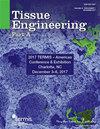Three-Dimensional Cell Printed Lock-Key Structure for Oral Soft and Hard Tissue Regeneration.
引用次数: 3
Abstract
Alveolar ridge absorbs rapidly following tooth extraction. To promote implant rehabilitation, an adequate bone and soft tissue volume are required. Three-dimensional (3D) cell printing technique provides the advantages of precise spatial distribution and personalization. In this study, 3D cell printing was used to establish a soft-hard construct that is composed of alginate/gelatin (AG)/gingival fibroblast cells (GFs) and alginate/gelatin/nano-hydroxyapatite (AGH)/bone marrow-derived mesenchymal stem cells (BMSCs). Physicochemical results showed that nano-hydroxyapatite (nHA) added in the bioink maintained its crystalline phase. In addition, an increase of viscosity, the improvement of compressive modulus (P<0.01), and slow degradation rate (P<0.01) were found after adding nHA. SEM showed cell stretched and attached well on the surface of the 3D printed construct. At day 7 after printing, the viability of GFs in AG was 94.80%±1.14, while BMSCs viability in AGH was 86.59%±0.75. PCR results indicated that the expression levels of ALP, RUNX-2, and OCN in BMSCs were higher in AGH than AG bioink (P<0.01). After 8-week implantation into the dorsum of 6-8-week-old male BALB/c nude mice, the cellular printed construct displayed a more integrated structure and better healing of subcutaneous tissue compared with the acellular printed construct. In conclusion, this 3D cell printed soft-hard construct exhibits favorable biocompatibility and has potential for alveolar ridge preservation.三维细胞打印口腔软硬组织再生的锁-键结构。
拔牙后牙槽嵴吸收迅速。为了促进种植体的康复,需要足够的骨和软组织体积。三维细胞打印技术具有精确的空间分布和个性化的优点。在这项研究中,利用3D细胞打印技术建立了由海藻酸盐/明胶(AG)/牙龈成纤维细胞(GFs)和海藻酸盐/明胶/纳米羟基磷灰石(AGH)/骨髓间充质干细胞(BMSCs)组成的软硬结构。理化结果表明,纳米羟基磷灰石(nHA)在生物墨水中保持了其结晶状态。此外,AGH在体外和体内对BMSCs的粘度增加、压缩模量(p p)、ALP、RUNX-2和OCN的改善均高于AG生物链接(p p)。这种3D细胞打印的软硬结构将在未来成为一种定制的牙槽嵴保存塞。
本文章由计算机程序翻译,如有差异,请以英文原文为准。
求助全文
约1分钟内获得全文
求助全文
来源期刊

Tissue Engineering Part A
CELL & TISSUE ENGINEERING-BIOTECHNOLOGY & APPLIED MICROBIOLOGY
自引率
0.00%
发文量
0
审稿时长
3 months
 求助内容:
求助内容: 应助结果提醒方式:
应助结果提醒方式:


